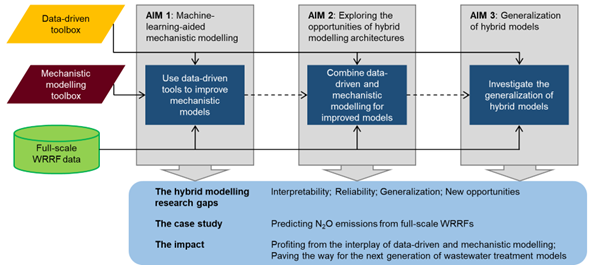Department Process Engineering
MAD4WW: Hybrid Mechanistic and Data-Driven Modelling for Wastewater Processes
Water resource recovery facilities (formerly known as wastewater treatment plants) are subject to a variety of requirements. In addition to complying with stringent effluent criteria, they are nowadays also expected to contribute to solutions of global challenges such as climate change or closing nutrient cycles. Computer models that reproduce the behavior of complex wastewater treatment processes can help to optimally navigate such multi-criteria situations. However, current models are not able to simulate all relevant chemical compounds, nor do they utilize the potential of artificial intelligence and machine learning to uncover unknown relationships. One important example is nitrous oxide emissions from biological nitrogen elimination: Nitrous oxide is a very potent greenhouse gas and its formation is difficult to predict in the complexity of activated sludge.
The main objective of this research project funded by the Swiss National Science Foundation (SNSF) is the systematic investigation of hybrid model approaches for the prediction of nitrous oxide emissions in biological wastewater treatment. In this context, hybrid means the combination of data-driven approaches (artificial intelligence, machine learning, etc.) and process-knowledge or physics-based models (differential equations, mass balances, etc.). Hybrid modelling is still relatively new and there is a great need for research in the areas of interpretability, reliability and generalization of these approaches.
Project goals
The MAD4WW project will investigate:
- how machine learning can help us to increase process understanding to improve mechanistic modelling (e.g. by using new data sources such as DNA data);
- how hybrid modelling can remain transparent and interpretable despite the integration of artificial intelligence
- the extent to which stochastic approaches can be introduced to reflect the reliability or uncertainty of the results;
Expected outcomes
On the one hand, this project will provide important scientific findings to substantially advance the modelling of complex wastewater processes and make them fit for the future thanks to hybrid approaches. On the other hand, the project will develop a model for predicting nitrous oxide emissions. This will not only expand our process understanding of the formation of nitrous oxide, but will also support engineers and operators in finding optimal operating strategies to meet with effluent criteria while minimizing greenhouse gas emissions.
Hybrid modelling
According to the IWA-MIA Hybrid Modelling Working Group, hybrid modelling is the combination of mechanistic and data-driven modelling approaches. Mechanistic models are based on physical, chemical or biological laws and are easy to interpret thanks to their cause-and-effect chains. However, they can only model known relationships. Data-driven models, on the other hand, learn the model structure themselves and can consider and integrate new data relatively easily and flexibly. However, these models are highly dependent on data quality and quantity. They have a limited ability to extrapolate and can only be interpreted to a limited extent as they are not based on causal relationships. Hybrid modelling attempts to utilize the respective advantages of both mechanistic and data-driven modelling approaches.
Coordination and cooperation with SCENE-project
The sub-project of SCENE (Joint Initiative of the ETH Domain) about the reduction of greenhouse gas emissions from wastewater treatment is an ideal complement to MAD4WW. In the SCENE-project, experiments and isotope analysis in collaboration with Empa (Dr. Joachim Mohn) will be used to understand the various mechanisms of nitrous oxide formation in biological wastewater treatment. Moreover, long-term measurement campaigns of nitrous oxide emissions at wastewater treatment plants are being investigated with advanced data analysis.








